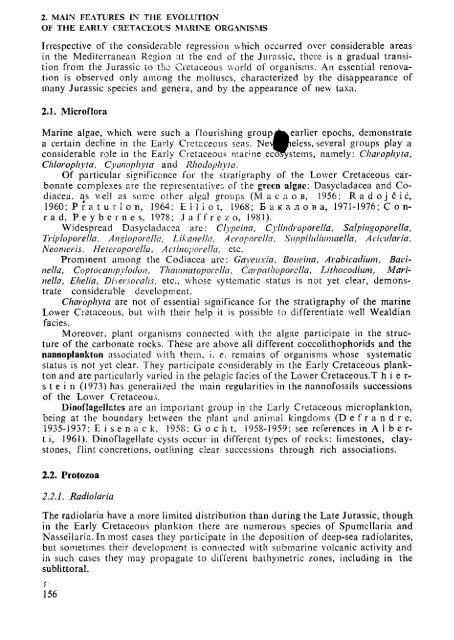THE MEDITERRANEAN LOWER CRETACEOUS
THE MEDITERRANEAN LOWER CRETACEOUS
THE MEDITERRANEAN LOWER CRETACEOUS
Create successful ePaper yourself
Turn your PDF publications into a flip-book with our unique Google optimized e-Paper software.
2. MAIN FEATURES IN <strong>THE</strong> EVOLUTION<br />
OF <strong>THE</strong> EARLY <strong>CRETACEOUS</strong> MARINE ORGANISMS<br />
Irrespective of the considerable regression which occurred over considerable areas<br />
in the Mediterranean Region at the end of the Jurassic, there is a gradual transition<br />
from the Jurassic to the Cretaceous world of organisms. An essential renovation<br />
is observed only among the molluscs, characterized by the disappearance of<br />
many Jurassic species and genera, and by the appearance of new taxa.<br />
2.1. Microflora<br />
Marine algae, which were such a flourishing group^^earlier epochs, demonstrate<br />
a certain decline in the Early Cretaceous seas. Nev^Bieless, several groups play a<br />
considerable role in the Early Cretaceous marne eco^stems, namely: Charophyta,<br />
Chlorophyta, Cyanophyta and Rhodophyta.<br />
Of particular significance for the stratigraphy of the Lower Cretaceous carbonate<br />
complexes are the representatives of the green algae: Dasycladacea and Codiacea,<br />
as well as some other algal groups (M а с л о в, 1956; Radojcic,<br />
1960; P r a t u r i о n, 1964; E 1 fi o"t, 1968; Б a к a л о в a, 1971-1976; Conrad,<br />
Peybernes, 1978; Jaffrezo, 1981).<br />
Widespread Dasycladacea are: Clypeina, Cylindroporella, Salpingoporella,<br />
Triploporella, AngioporeHa, Likanella, Acroporella, Siippiluliumaella, Acicularia,<br />
Neomeris, Heteroporella, Actinoporella, etc.<br />
Prominent among the Codiacea arc: Gayeuxia, Boueina, Arabicadium, Bacinella,<br />
Coptocampylodon, Thaumatoporclla, Carpathoporclla, Lithocodium, Marinella,<br />
Ehelia, Diversocalis, etc., whose systematic status is not yet clear, demonstrate<br />
considerable development.<br />
Charophyta are not of essential significance for the stratigraphy of the marine<br />
Lower Cretaceous, but with their help it is possible to differentiate well Wealdian<br />
facies.<br />
Moreover, plant organisms connected with the algae participate in the structure<br />
of the carbonate rocks. These are above all different coccolithophorids and the<br />
nannoplankton associated with them, i. e. remains of organisms whose systematic<br />
status is not yet clear. They participate considerably in the Early Cretaceous plankton<br />
and are particularly varied in the pelagic facies of the Lower Cretaceous.T hi e rstein<br />
(1973) has generalized the main regularities in the nannofossils successions<br />
of the Lower Cretaceous.<br />
Dinoflagellr.tcs are an important group in the Early Cretaceous microplankton,<br />
being at the boundary between the plant and animal kingdoms (Defrandre,<br />
1935-1937; E i s e n а с k, 1958; G о с h t, 1958-1959; see references in A 1 b e rt<br />
i, 1961). Dinoflagellate cysts occur in different types of rocks: limestones, claystones,<br />
flint concretions, outlining clear successions through rich associations.<br />
2.2. Protozoa<br />
2.2.1. Radiolaria<br />
The radiolaria have a more limited distribution than during the Late Jurassic, though<br />
in the Early Cretaceous plankton there are numerous species of Spumellaria and<br />
Nasseilaria. In most cases they participate in the deposition of deep-sea radiolarites,<br />
but sometimes their development is connected with submarine volcanic activity and<br />
in such cases they may propagate to different bathymétrie zones, including in the<br />
sublittoral.<br />
156

















